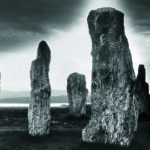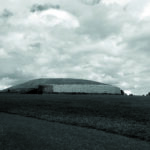There are places on earth that touch us in a strange way. Pasts and primordial grounds that we had forgotten are awakened.
While strolling through Göttingen in the 1980s, I came across a photo calendar about Scotland displayed in the window of a bookshop. I was immediately drawn to the black-and-white photos of ancient castles, stone circles and broken telephone boxes on lonely moorland. I bought the calendar and framed the most beautiful pictures for my student flat in Berlin-Neukölln. Like a wake-up call from secret regions of Europe, they echoed daily until I was finally able to visit Scotland for the first time in 1987. Never before had a country and a landscape so overwhelmed me; tears often flowed when I passed Gaelic place-name signs or when I visited ancient stone circles, which unfolded their effect above all under dramatic skies which Scotland so abundantly offers. The magical places, the earth and the sky seemed to become a mirror for inner landscapes and enabled me to travel to seductive regions of my unconscious that were closed to me in my “daylight” German home. What was going on here, why was I so drawn to all this?
Overwhelmed by new feelings, I sometimes wondered if I had lived in this country before and now distant memories from past lives washed up, which I could only integrate into my present existence with difficulty. Less spiritually-minded friends to whom I told such things did not have the same feelings about them, but they did about the magic of “sacred places”, which I was able to convey to them well. The Scottish earth is saturated with spiritual places of power and cult that reach back through the Christian Middle Ages and the era of the Celts to distant megalithic times and of which I had never heard in Germany. I often even had the impression that in the German media and educational institutions this secret heritage of Europe was withheld as if it had never existed. On television, there were constant reports about the pyramids of Egypt, the monasteries of Tibet and the ancient temples in Latin America, but the places of worship or myths of our European ancestors hardly ever made an appearance. On further journeys, I discovered a fascinating cultural-historical heritage in Scotland, which, with the help of early Christian sun crosses, holy springs, menhirs and dolmens, brought me closer to a spirituality that was previously unknown to me and strongly connected to the earth. There was no incense wafting here, but I was surrounded by fresh spicy air, often heard the sound of the sea in the distance and felt the flapping of sea birds and birds of prey above me. There was something wild in the air of these lonely places, even if they were not stone circles but overgrown ruins of churches and cemeteries: besides feelings of devotion, there was also room for those of passion, dream and untamed imagination in these “experiences of God”.
The temples of the Celts and megaliths, but also the cemeteries and hermitages of the Irish-Scottish monks were often built on seashores, where they sometimes descended dramatically to the eternal roar and rage of the elements. In general, nature in all its diversity was always integrated into the aura of these places, so that different contemplative moods prevailed there which did not in the churches of Germany: even at sacred springs, water constantly bubbled up from the earth and the smell of fresh water accompanied my religious moods like a mantra. Here, the “sacred” could be experienced differently than in the church rituals known so far; standing stones, stone circles or passage graves also drew their mood from the change of day and seasons.

The Stone Circle of Callanish, Isle of Lewis, Scotland
(Photo Rüdiger Sünner)
An English friend with whom I visited the huge stone circle of Callanish on the Hebridean island of Lewis summed it up well when she said: “In the midst of this circle there is more summer in summer and more winter in winter.” The complex with its mighty stone columns acted as a focus that amplified the surroundings in all moods: when it rained, the water beading off them made all the power and beauty of the rain even more visible, on the stones warmed in August I felt the summer heat more clearly, and at night I thought I could see the stars circling above the megalithic temple. Here, “God” or “the divine” were not purely spiritual entities that had overcome all nature and physicality but appeared even more clearly in the elements. And death was also integrated into nature differently here than in the local cemeteries. I was deeply fascinated by the research of a British archaeologist who had found out that the builders of the megalithic complexes probably assumed that the fluid remains of the corpses were also supposed to “nourish” the burial complex as such. Certain artificially roughened structures on the stone walls led him to the assumption that they wanted to keep them porous in order to let the physical and perhaps also spiritual energy flows of the dead flow into them. After his death, man thus connected himself completely with the surrounding landscape instead of flying away into distant and abstract heavens.
Heaven and earth, spirit and matter seemed to move closer together in the cult landscapes of Scotland than in the churches of my homeland, where everything – also in terms of the architecture – was oriented to striving upwards. God seemed to dwell in these Nordic soul landscapes not in rapturous heavens, but everywhere on earth, in every blade of grass, frog, in every crumb of earth and in the salty spray of the sea. On Celtic sun crosses near a coast, I once saw the image of leaping dolphins and a deep feeling of happiness flowed through me. These enchanting creatures were also allowed to participate in the redemptive work of Christianity, according to the wonderful sentence of Novalis, the most “Celtic” of all German poets: “If God could become man, he can also become stone, plant, animal and element, and perhaps in this way there is a perpetual redemption of nature.”
My many visits to Scotland, and later also to Ireland, Cornwall and Wales, also stimulated me to concern myself intensively with a variety of Christianity that was widespread there and which I did not know from my homeland: the so-called “Iro-Scottish Christianity”, which was different in many respects from the “Roman” Christianity. Above all, a greater closeness to nature was noticeable here: Monasteries and churches quite naturally inherited the sacred oaks of the previous Druid religion and did not destroy them, as, for example, the missionary Boniface had done with the “Dona oak” of the Germanic tribes. Many Iro-Scottish priests held their masses in forests or by the sea, which were accompanied by the singing of birds, which were also greeted as feathered angel messengers. In the Celtic countries, I sensed a spirituality that was less damaged by the break with the “earth” than, for example, in Cologne Cathedral, where my father had often taken me to Sunday mass as a child. Here, the upwardly striving stone pillars of the enormous sacred building rather intimidated me, as did the echoing voice of the preachers and the roaring organ sounds that constantly wanted to draw us up to something “higher” and “pure”. One was supposed to be silent, to bow and kneel before a raptured God whom the child’s imagination could only imagine as a physically intangible and intimidating figure. As a “father”, “lord” and “ruler”, as an infallible and immaculate abstract somewhere in the cosmic distances, who had sent his son to earth, but who nevertheless always remained invisible.

Megalithic burial site of Newgrange, Ireland
(Photo Rüdiger Sünner)
In Scotland and Ireland, on the other hand, I also sensed a feminine element in the spiritual atmosphere there; the “sacred earth” was saturated with concepts such as “Mater” and “Anima”, which had a redeeming and relieving effect on me. Studies by Lithuanian archaeologist Marija Gimbutas confirmed this feeling by pointing out that the whole symbolism of the Neolithic burial complexes was strongly female-tinged and possibly had to do with a cult of the “Great Goddess”. The tumuli did indeed often seem to me like a belly into which one could crawl as if through a vulva, and spiral ornaments and female figurines found in them confirmed this interpretation. It was in this country that I first understood the sacral meaning of terms like “Mother Earth” or “Mother Nature”; I understood that many ancient cultures had also thanked the earth for its fertility and bounty with their shrines and saw it as a motherly womb that takes you back after death.
Were all these just rapturous fantasies or regressive longings of a spiritually malnourished German who only abused the moss-covered ruins of Celtic northern Europe for his subjective projections? Initially, I had only reacted purely emotionally to the legacies of the megaliths, Celts, Grail tellers and Iro-Scottish monks, but gradually I read more and more about them and based my feelings on serious literature. And even if not everything I felt coincided with the research of archaeologists, it created moods and ideas that seemed to me to fit quite well into our present. In times of dramatic ecological crises, what could be more fitting than to combine spirituality with devotional exercises towards a nature understood as “sacred”? Wasn’t our civilisation characterised by an enormous ingratitude towards an environment that was only plundered as a raw material dump? And weren’t there also more and more people leaning towards nature-religious views in order to thank the “earth” as a nurturing and giving “mother”? Didn’t the German forester Peter Wohlleben land several bestsellers with titles like Das geheime Leben der Bäume (The Secret Life of Trees), Das Seelenleben der Tiere (The Soul Life of Animals), Hörst du, wie die Bäume sprechen? (Do You Hear How the Trees Speak?) and The Secret Wisdom of Nature calling for a different way of dealing with forests, animals and the earth?
Today I believe that my discovery of the “sacred earth” in the Celtic regions of Europe not only has a lot to do with the fact that I have a deep spiritual connection to nature, but also that it allowed a buried “romantic” dimension in me to find expression. For German Romanticism also had this kind of soulful relationship with nature: Herder, Goethe, Schiller, Schelling, Novalis, Hölderlin, Eichendorff, Annette von Droste-Hülshoff, Caspar David Friedrich, the Brothers Grimm and many others saw something “sacred” in nature and paid homage to it in their works. For reasons worthy of further investigation, much of this has been lost, even the “Greens” or the followers of “Fridays for Future” no longer know anything about it. But in the Soul Landscapes of the North, I was allowed to reconnect with these wonderful traditions and will continue to dive into this precious heritage in films and books.
It has become a centrepiece of my life and a friend’s intuition was probably right when he once called me the “rebirth of a Celtic bard”. With a twinkle in my eye, I gladly accept this designation.
More about my soul landscapes can be found in my books Der Geschmack der Unendlichkeit – Spiritualität im Alltag (The Taste of Infinity – Spirituality in Everyday Life) (Europa-Verlag 2022) and in Wildes Denken – Europa im Dialog mit spirituellen Kulturen der Welt (Wild Thinking – Europe in Dialogue with Spiritual Cultures of the World) (Europa-Verlag 2020) and also many of my films tell about it: Tree of Life, Geheimes Deutschland (Secret Germany), Engel über Europa (Angels over Europe), Wildes Denken (Wild Thinking), all available as DVD and VOD at www.absolutmedien.de.

